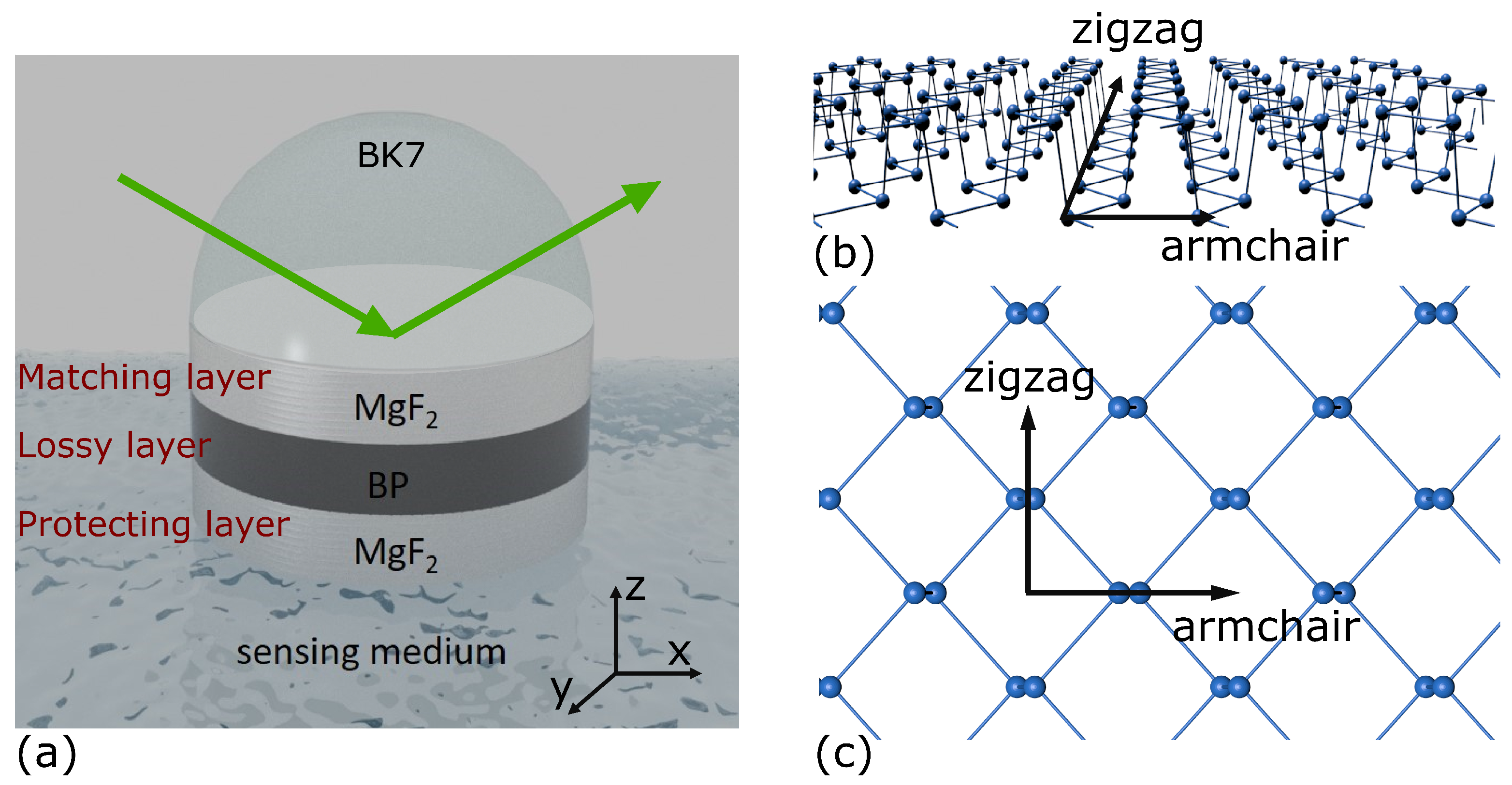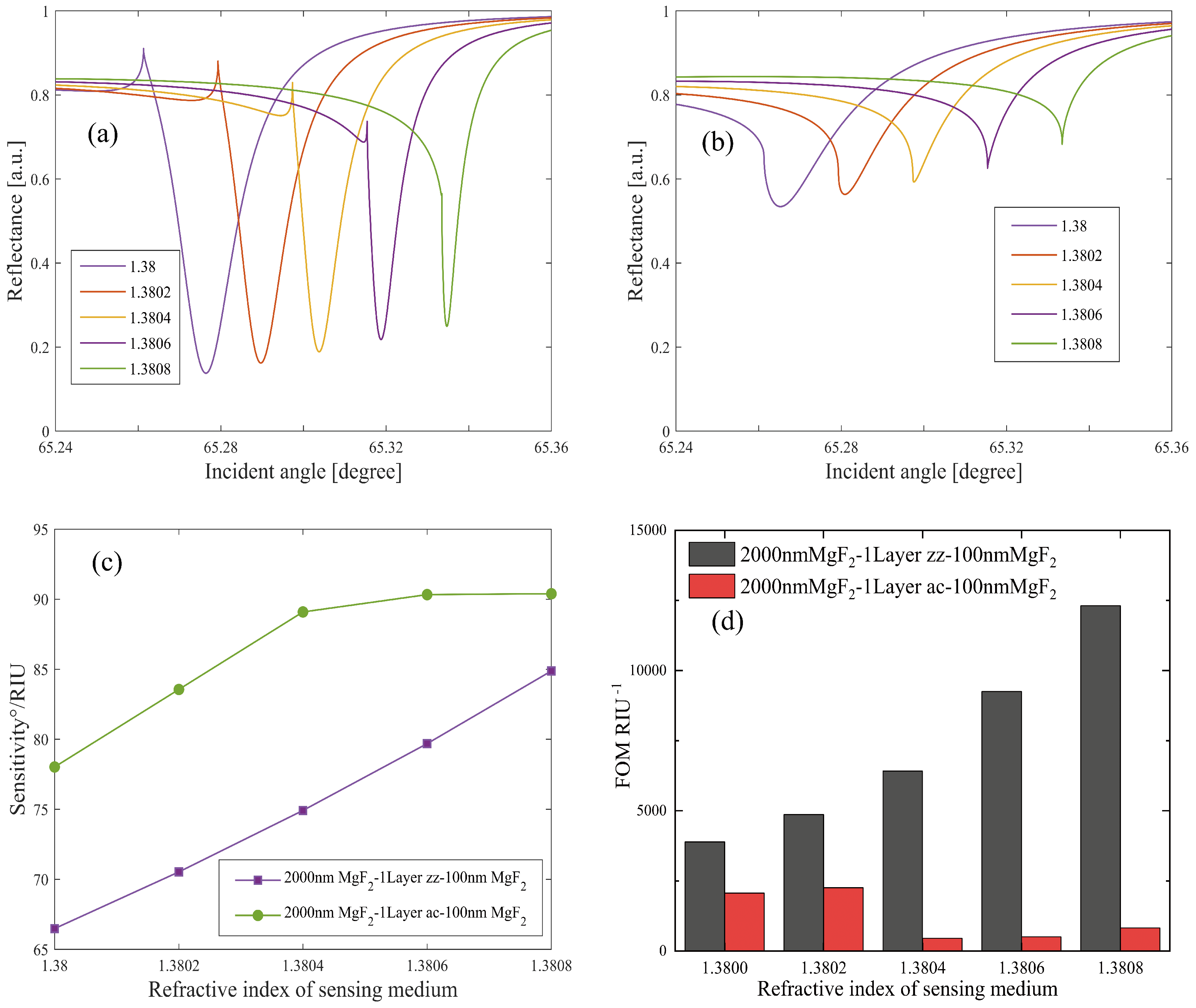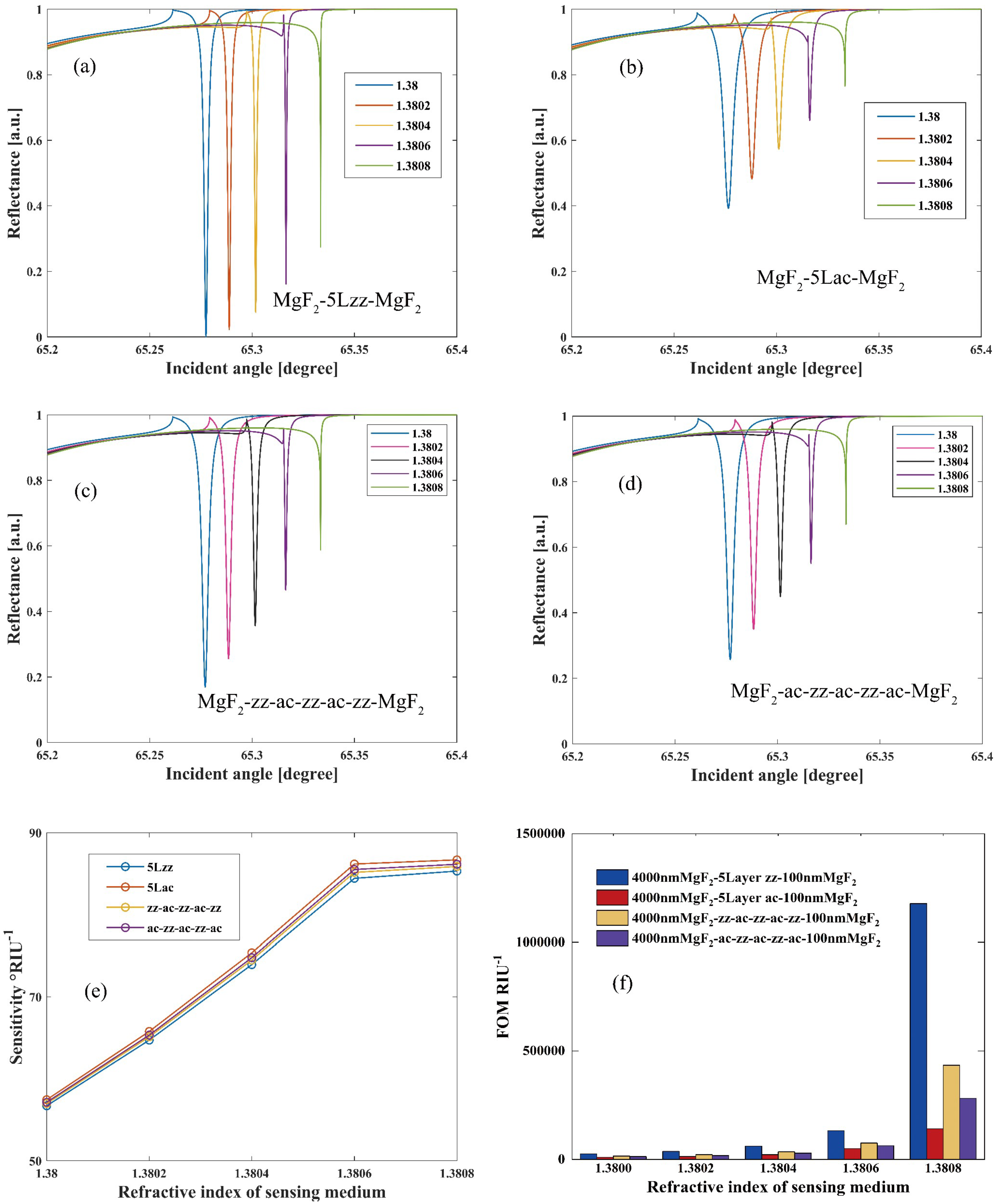Lossy Mode Resonance Sensors Based on Anisotropic Few-Layer Black Phosphorus
Abstract
1. Introduction
2. Materials and Methods
3. Results and Discussion
4. Conclusions
Supplementary Materials
Author Contributions
Funding
Institutional Review Board Statement
Informed Consent Statement
Data Availability Statement
Conflicts of Interest
References
- Marciniak, M.; Grzegorzewski, J.; Szustakowski, M. Analysis of lossy mode cut-off conditions in planar waveguides with semiconductor guiding layer. IEE Proc. J. Optoelectron. 1993, 140, 247–252. [Google Scholar] [CrossRef]
- Ozcariz, A.; Dominik, M.; Smietana, M. Lossy mode resonance optical sensors based on indium-gallium-zinc oxide thin film. Sens. Actuat. A-Phys. 2019, 290, 20–27. [Google Scholar] [CrossRef]
- Corres, J.M.; Ascorbe, J.; Arregui, F.J.; Matias, I.R. Tunable electro-optic wavelength filter based on lossy-guided mode resonances. Opt. Express 2013, 21, 31668–31677. [Google Scholar] [CrossRef] [PubMed]
- Zubiate, P.; Zamarreno, C.R.; Villar, I.D.; Matias, I.R.; Arregui, F.J. Tunable optical fiber pH sensors based on TE and TM Lossy Mode Resonances (LMRs). Sens. Actuat. B-Chem. 2016, 231, 484–490. [Google Scholar] [CrossRef]
- Elosua, C.; Vidondo, I.; Arregui, F.J.; Bariain, C.; Luquin, A.; Laguna, M.; Matias, I.R. Lossy mode resonance optical fiber sensor to detect organic vapors. Sens. Actuat. B-Chem. 2013, 187, 65–71. [Google Scholar] [CrossRef]
- Jacak, W.A. Quantum Nano-Plasmonics; Cambridge University Press: Cambridge, UK, 2020; pp. 83–96. [Google Scholar]
- Chen, J.; Sun, C.; Rong, K.; Li, H.; Gong, Q. Polarization-free directional coupling of surface plasmon polaritons. Laser Photonics Rev. 2015, 9, 419–426. [Google Scholar] [CrossRef]
- Tugchin, B.N.; Janunts, N.; Klein, A.E.; Steinert, M.; Fasold, S.; Diziain, S.; Sison, M.; Kley, E.; Tunnermann, A.; Pertsch, T. Plasmonic tip based on excitation of radially polarized conical surface plasmon polariton for detecting longitudinal and transversal fields. ACS Photonics 2015, 2, 1468–1475. [Google Scholar] [CrossRef]
- Usha, S.P.; Mishra, S.K.; Gupta, B.D. Fiber optic hydrogen sulfide gas sensors utilizing ZnO thin film/ZnO nanoparticles: A comparison of surface plasmon resonance and lossy mode resonance. Sens. Actuat. B-Chem. 2015, 218, 196–204. [Google Scholar] [CrossRef]
- Villar, I.D.; Torres, V.; Beruete, M. Experimental demonstration of lossy mode and surface plasmon resonance generation with Kretschmann configuration. Opt. Lett. 2015, 40, 4739–4742. [Google Scholar] [CrossRef]
- Del Villar, I.; Zamarreño, C.R.; Hernaez, M.; Arregui, F.J.; Matias, I.R. Generation of lossy mode resonances with absorbing thin-films. J. Light. Technol. 2010, 28, 3351–3357. [Google Scholar] [CrossRef]
- Del Villar, I.; Zamarreño, C.R.; Hernaez, M.; Arregui, F.J.; Matias, I.R. Lossy mode resonance generation with indium-tin-oxide-coated optical fibers for sensing applications. J. Light. Technol. 2010, 28, 111–117. [Google Scholar] [CrossRef]
- Zhang, Y.; Zhang, P.; Zhao, M.; Xu, D.; Wang, J.; Li, Z.; Tang, T. A high sensitivity lossy mode resonance refractive index sensor based on SBS structure. Results Phys. 2022, 36, 105454. [Google Scholar] [CrossRef]
- Zhang, Y.; Zhang, P.; Zhao, M.; Li, Z.; Xu, D.; Tong, C.; Shen, J.; Li, C. Theoretical modeling and investigations of lossy mode resonance prism sensor based on TiO2 film. Opt. Express 2022, 30, 32483–32500. [Google Scholar] [CrossRef] [PubMed]
- Villar, I.D.; Arregui, F.J.; Zamarreño, C.R.; Corres, J.M.; Bariain, C.; Goicoechea, J.; Elosua, C.; Hernaez, M.; Rivero, P.J.; Socorro, A.B.; et al. Optical sensors based on lossy-mode resonances. Sens. Actuat. B-Chem. 2017, 240, 174–185. [Google Scholar] [CrossRef]
- Hu, S.; Shi, W.; Chen, Y.; Chen, Y.; Liu, G.S.; Chen, L.; Luo, Y.; Chen, Z. Dispersion management for hyperbolic-metamaterials based surface plasmon resonance sensor towards extremely high sensitivity. J. Light. Technol. 2022, 40, 887–893. [Google Scholar] [CrossRef]
- Cai, H.; Shan, S.; Wang, X. High sensitivity surface plasmon resonance sensor based on periodic multilayer thin films. Nanomaterials 2021, 11, 3399. [Google Scholar] [CrossRef]
- Pandey, P.S.; Raghuwanshi, S.K.; Kumar, S. Recent advances in two-dimensional materials-based Kretschmann configuration for SPR sensors: A review. IEEE Sens. J. 2021, 22, 1069–1080. [Google Scholar] [CrossRef]
- Zhao, Y.; Wu, L.; Gan, S.; Ruan, B.; Zhu, J.; Dai, X.; Xiang, Y. High figure of merit lossy mode resonance sensor with graphene. Plasmonics 2019, 14, 929–934. [Google Scholar] [CrossRef]
- Wu, L.; Zhu, J.; Gan, S.; Ma, Q.; Dai, X.; Xiang, Y. Application of Few-Layer Transition Metal Dichalcogenides to Detect the Refractive Index Variation in Lossy-Mode Resonance Sensors with High Figure of Merit. IEEE Sens. J. 2019, 5030–5034. [Google Scholar] [CrossRef]
- Liu, N.; Wang, S.; Cheng, Q.; Pang, B.; Lv, J. Two-Dimensional Transition Metal Dichalcogenides-Based High Sensitivity Lossy Mode Refractive Index Sensor. IEEE Sens. J. 2021, 21, 6043–6049. [Google Scholar] [CrossRef]
- Wu, L.; Xiang, Y.; Qin, Y. Lossy-mode-resonance sensor based on perovskite nanomaterial with high sensitivity. Opt. Express 2021, 29, 17602–17612. [Google Scholar] [CrossRef] [PubMed]
- Xia, F.; Wang, H.; Jia, Y. Rediscovering black phosphorus as an anisotropic layered material for optoelectronics and electronics. Nat. Commun. 2014, 5, 4458. [Google Scholar] [CrossRef]
- Li, L.; Yu, Y.; Ye, G.J.; Ge, Q.; Ou, X.; Wu, H.; Feng, D. Black phosphorus field-effect transistors. Nat. Nanotechnol. 2014, 9, 372–377. [Google Scholar] [CrossRef] [PubMed]
- Rodin, A.S.; Carvalho, A.; Neto, A.H.C. Strain-Induced Gap Modification in Black Phosphorus. Phys. Rev. Lett. 2014, 112, 176801. [Google Scholar] [CrossRef] [PubMed]
- Tao, J.; Shen, W.; Wu, S.; Liu, L.; Feng, Z.; Wang, C.; Hu, C. Mechanical and Electrical Anisotropy of Few-Layer Black Phosphorus. ACS Nano 2015, 9, 11362–11370. [Google Scholar] [CrossRef]
- Liu, H.; Neal, A.T.; Zhu, Z.; Luo, Z.; Xu, X.; Tománek, D. Phosphorene: An Unexplored 2D Semiconductor with a High Hole Mobility. ACS Nano 2014, 8, 4033–4041. [Google Scholar] [CrossRef]
- Wu, L.; Wang, Q.; Ruan, B.; Zhu, J.; You, Q.; Dai, X.; Xiang, Y. High-performance lossy-mode resonance sensor based on few-layer black phosphorus. J. Phys. Chem. C 2018, 122, 7368–7373. [Google Scholar] [CrossRef]
- Cho, S.Y.; Lee, Y.; Koh, H.J.; Jung, H.; Kim, J.S.; Yoo, H.W.; Kim, J.; Jung, H.T. Superior chemical sensing performance of black phosphorus: Comparison with MoS2 and graphene. Adv. Mater. 2016, 28, 7020–7028. [Google Scholar] [CrossRef]
- Qiao, J.; Kong, X.; Hu, Z.X.; Yang, F.; Ji, W. High-mobility transport anisotropy and linear dichroism in few-layer black phosphorus. Nat. Commun. 2014, 5, 4475. [Google Scholar] [CrossRef]
- Biswas, S.; Grajower, M.Y.; Watanabe, K.; Taniguchi, T.; Atwater, H.A. Broadband electro-optic polarization conversion with atomically thin black phosphorus. Science 2021, 374, 448–453. [Google Scholar] [CrossRef]
- Lin, M.L.; Leng, Y.C.; Cong, X.; Meng, D.; Wang, J.; Li, X.L.; Yu, B.; Liu, X.L.; Yu, X.F.; Tan, P.H. Understanding angle-resolved polarized Raman scattering from black phosphorus at normal and oblique laser incidences. Sci. Bull. 2020, 65, 1894–1900. [Google Scholar] [CrossRef] [PubMed]
- Mao, N.; Tang, J.; Xie, L.; Wu, J.; Han, B.; Lin, J. Optical anisotropy of black phosphorus in the visible regime. J. Am. Chem. Soc. 2016, 138, 300–305. [Google Scholar] [CrossRef] [PubMed]
- Islam, A.; Du, W.; Pashaei, V.; Jia, H.; Wang, Z. Discerning black phosphorus crystal orientation and anisotropy by polarized reflectance measurement. ACS Appl. Mater. Interfaces 2018, 10, 25629–25637. [Google Scholar] [CrossRef] [PubMed]
- Jiang, J.W. The third principal direction besides armchair and zigzag in single-layer black phosphorus. Nanotechnology 2015, 26, 365702. [Google Scholar] [CrossRef]
- Lan, S.; Rodrigues, S.; Kang, L.; Cai, W. Visualizing optical phase anisotropy in black phosphorus. ACS Photonics 2016, 3, 1176–1181. [Google Scholar] [CrossRef]
- Wu, L.; Guo, J.; Wang, Q.; Lu, S.; Dai, X.; Xiang, Y.; Fan, D. Sensitivity enhancement by using few-layer black phosphorus-graphene/TMDCs heterostructure in surface plasmon resonance biochemical sensor. Sens. Actuat. B-Chem. 2017, 249, 542–548. [Google Scholar] [CrossRef]
- Zhao, W.M.; Wang, Q. Analytical solutions to fundamental questions for lossy mode resonance. Laser Photonics Rev. 2023, 17, 2200554. [Google Scholar] [CrossRef]
- Pan, T.; Lu, D.; Xin, H.; Li, B. Biophotonic probes for bio-detection and imaging. Light Sci. Appl. 2021, 10, 124. [Google Scholar] [CrossRef]
- Ross, A.M.; Paternó, G.M.; Dal Conte, S.; Scotognella, F.; Cinquanta, E. Anisotropic complex refractive indices of atomically thin materials: Determination of the optical constants of few-layer black phosphorus. Materials 2020, 13, 5736. [Google Scholar] [CrossRef]
- Jiang, H.; Shi, H.; Sun, X.; Gao, B. Optical anisotropy of few-layer black phosphorus visualized by scanning polarization modulation microscopy. ACS Photonics 2018, 5, 2509–2515. [Google Scholar] [CrossRef]
- Li, D.K.; Wang, S.Y.; Yan, X.Q.; Su, B.W.; Hu, Z.; Liu, Z.B. Anisotropic goos–hänchen shift in few-layer two-dimensional materials. Appl. Phys. Lett. 2022, 150, 053105. [Google Scholar] [CrossRef]
- Hu, M.; Li, M.; Li, M.Y.; Wen, X.; Deng, S.; Liu, S.; Lu, H. Sensitivity Enhancement of 2D Material-Based Surface Plasmon Resonance Sensor with an Al–Ni Bimetallic Structure. Sensors 2023, 23, 1714. [Google Scholar] [CrossRef]
- Lee, S.Y.; Yee, K.J. Black phosphorus phase retarder based on anisotropic refractive index dispersion. 2D Mater. 2021, 9, 015020. [Google Scholar] [CrossRef]
- Cupo, A.; Meunier, V. Quantum confinement in black phosphorus-based nanostructures. J. Phys. Condens. Mat. 2017, 29, 283001. [Google Scholar] [CrossRef]
- Saini, R.; Kumar, A.; Bhatt, G.; Kapoor, A.; Paliwal, A.; Tomar, M.; Gupta, V. Lossy mode resonance-based refractive index sensor for sucrose concentration measurement. IEEE Sens. J. 2019, 20, 1217–1222. [Google Scholar] [CrossRef]
- Tran, V.; Soklaski, R.; Liang, Y.; Yang, L. Layer-controlled band gap and anisotropic excitons in few-layer black phosphorus. Phys. Rev. B 2014, 89, 235319. [Google Scholar] [CrossRef]
- Cakir, D.; Sevik, C.; Peeters, F.M. Significant effect of stacking on the electronic and optical properties of few-layer black phosphorus. Phys. Rev. B 2015, 92, 165406. [Google Scholar] [CrossRef]
- Wei, Y.; Lu, F.; Zhou, T.; Luo, X.; Zhao, Y. Stacking sequences of black phosphorous allotropes and the corresponding few-layer phosphorenes. Phys. Chem. Chem. Phys. 2018, 20, 10185–10192. [Google Scholar] [CrossRef]
- Kluczyk, K.; David, C.; Jacak, J.; Jacak, W. On modeling of plasmon-induced enhancement of the efficiency of solar cells modified by metallic nano-particles. Nanomaterials 2018, 9, 3. [Google Scholar] [CrossRef]




Disclaimer/Publisher’s Note: The statements, opinions and data contained in all publications are solely those of the individual author(s) and contributor(s) and not of MDPI and/or the editor(s). MDPI and/or the editor(s) disclaim responsibility for any injury to people or property resulting from any ideas, methods, instructions or products referred to in the content. |
© 2024 by the authors. Licensee MDPI, Basel, Switzerland. This article is an open access article distributed under the terms and conditions of the Creative Commons Attribution (CC BY) license (https://creativecommons.org/licenses/by/4.0/).
Share and Cite
Shen, Y.; Zhu, Q.; Chen, Z.; Wu, J.; Chen, B.; Dai, E.; Pan, W. Lossy Mode Resonance Sensors Based on Anisotropic Few-Layer Black Phosphorus. Nanomaterials 2024, 14, 736. https://doi.org/10.3390/nano14090736
Shen Y, Zhu Q, Chen Z, Wu J, Chen B, Dai E, Pan W. Lossy Mode Resonance Sensors Based on Anisotropic Few-Layer Black Phosphorus. Nanomaterials. 2024; 14(9):736. https://doi.org/10.3390/nano14090736
Chicago/Turabian StyleShen, Yanting, Qifeng Zhu, Zhuo Chen, Jiawei Wu, Binghuang Chen, Enwen Dai, and Weiqing Pan. 2024. "Lossy Mode Resonance Sensors Based on Anisotropic Few-Layer Black Phosphorus" Nanomaterials 14, no. 9: 736. https://doi.org/10.3390/nano14090736
APA StyleShen, Y., Zhu, Q., Chen, Z., Wu, J., Chen, B., Dai, E., & Pan, W. (2024). Lossy Mode Resonance Sensors Based on Anisotropic Few-Layer Black Phosphorus. Nanomaterials, 14(9), 736. https://doi.org/10.3390/nano14090736





